Here are listed the public guided walks and tours I have currently got in my diary. I will be adding others all the time.
A Boy From Haggerston before the War. 6pm 1st May 2025 Shoreditch Library. Free To book:
Myths, Legends, Archaeology and the Origins of London 11.30am Sun 25th May 25 To book
The Decline And Fall Of Roman London Walk 3pm Sun May 25 To book
The Rebirth Of Saxon London Archaeology Walk 10.30am Sat 7th June 2025 To Book
The Peasants Revolt Anniversary Guided Walk 6.30pm Wed 11th June 25 To book
The Archaeology of London Walk 6.30pm Fri 11th July 2025 To Book
Tudor London – The City of Wolf Hall 11.30am 13th July 2025 To Book
Jane Austen’s London Anniversary Walk 3pm Sunday 13th July 25 To book
Roman London – Literary & Archaeology Walk 11.30 am Sat 2nd Aug 2025 To Book
Chaucer’s Medieval London Guided Walk 2:30pm Sat 2nd Aug 2025 To Book
Myths, Legends, Archaeology and the Origins of London 11.00am Sat 11th Aug 2025 to Book
The Rebirth Of Saxon London Archaeology Walk 11.30am Sat 8th Nov 2025 To Book
Charles I and the Civil War. Martyrdom Anniversary Walk Jan 30th 2026 To book
For a complete list of my guided walks for London Walks in 2025 look here
May the Swarm of Bees be with you! May 5th

In 2018, on 30th May, I was perturbed to find a swarm of Bees hanging outside my front door. Frightened of leaving my house, I rang a local beekeeper, who came to take possession of the Bees and take them to a new home. By the time he came, they had moved 20 yards to a Buddleia bush.

A Swarm of Bees in May
‘Five Hundred Points of Good Husbandry’ published 1573, suggests we should:
‘Take heed to thy Bees, that are ready to swarm, the loss thereof now, is a crown’s worth of harm.’ The loss was particularly hard in May or June as the country verse tells us:
A swarm in May
Is worth a load of hay
A swarm in June
Is worth a silver spoon
A swarm in July
Is not worth a fly.‘
According to Hillman’s ‘Tusser Redivus’ of 1710, swarming in May produces particularly good honey. He advises following the bees to retrieve them:
‘You are entitled by custom to follow them over anyone’s land and claim them … but only so long as you ‘ting-tang’ as you go, by beating some metal utensil – the sound whereof is also said to make your bees stop.’
Much of the above is quoted from The Perpetual Almanac of Folklore by Charles Kightly.
Queen Bee
Bees swarm when a new Queen Bee takes a proportion of the worker bees to form a new colony. They will latch unto a branch or a shrub, even a car’s wing mirror. Then sending worker bees out searching for a suitable new home, such as a hollow tree. There may be hundreds or even thousands in the new colony. This may be very alarming, as I found, as I could not go out without walking through a cloud of bees. But, at this point, they will not be aggressive as they do not have a hive to protect. Look here for more information on swarming.
Sweet, Long Distance Flyers
An average hive will produce 25 lbs of honey, and the bees will fly 1,375,000 miles to produce it. This is like flying 55 times around the world (according to the British beekeepers Association (and my maths)) https://www.bbka.org.uk/honey
Helping Bees
Bees are still having a hard time as their habitats are diminishing and threats increasing. In July, DEFRA hosts ‘Bees Needs Week’ which aims to increase public awareness of the importance of pollinators.
They suggest we can help by these 5 simple actions
- Grow more nectar rich flowers, shrubs and trees. Using window or balcony boxes are good options if you don’t have a garden.
- Let patches of garden and land grow wild.
- Cut grass less often.
- Do not disturb insect nests and hibernation spots.
- Think carefully about whether to use pesticides.
For more above Bees Needs Week look here:
Patron Saints of Bees include: St. Ambrose, St. Gobnait, and St. Valentine. Click here to see my post of St Valentine.
First Published 2024, revised 2025
Geoffrey Chaucer & the Charge of Raptus May 4th
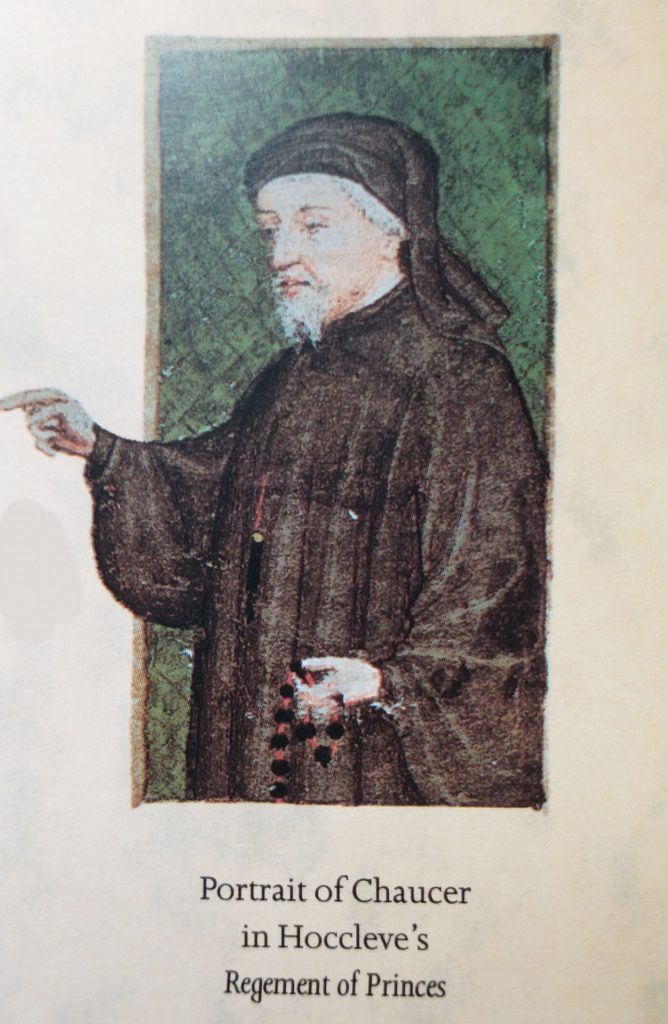
For many years, there has been a cloud over Geoffrey Chaucer’s name. Medieval records show that, in 1380, Geoffrey Chaucer and Cecily Chaumpaigne, the daughter of a London baker were involved in a legal case involving the term ‘raptus’.
The term can mean rape or kidnapping. The May 4, Close Rolls of the English Chancery, releases Chaucer from “all manner of actions related to my raptus” (“omnimodas acciones, tam de raptu meo”). So, we know he was not charged for the offense, but the original records suggest he was accused of it and possibly paid his way out of difficulty.
I attended a lecture about 18 months relating recently discoveries by Euan Roger and Sebastian Sobecki. It shone light on the long misunderstood case, and cleared Chaucer of rape or kidnapping. The scholars were investigating medieval records which academic opinion thought not worth persuing. But in the papers they discovered that Chaucer and Cecily Chaumpaigne were on the same side in the legal dispute.
Rather than being a case of Chaucer mistreating Champaigne, the two of them were accused by her former employer, Thomas Staundon, of raptus. The case was caused ultimately by the shortage of labour following the Black Death of 1348. It killed over one third of the population of the UK. With the loss of life, the ruling classes found they were having to pay more for labourers, and goods. So, having control of Parliament, they passed legislation called the Statue of Labourers which insisted that people should work at the same pay rate and conditions as before the Black Death. Labourers had to swear to keep to the old conditions, and drastic consequences, including imprisonment, awaited those who transgressed. It was one of the major causes of the Peasants Revolt of 1381 as the legislation was still in use 30 years later.
So, it would seem that Cecily left her employer to work for Geoffrey Chaucer (presumably at a more realistic higher pay rate). Her former employer pressed charges against her and Chaucer for breaking the financial rules and poaching a worker.
This is a very crude summary of a fascinating piece of historical detective work. To find out more, read The Chaucer Review Volume 57, Number 4, 2022 Penn State University Press or follow this link https://muse.jhu.edu/pub/2/article/867751
For my post of Chaucer and St Valentine’s Day follow this link.
For ‘May the 4th be with you’ see my post here
First posted on May 4th, 2025
May the 4th be with you

This is based on the flimsy premise/play on words that ‘May the 4th be with you’ is similar to ‘May the Force be with you’. The origins of the idea are explained in detail here.
In the UK Census of 2011, 390,127 self-declared themselves as Jedi under the question about religion. However, ten years later, the number declined to a mere 1,600. The cause appears to be a call from the Humanists that it was important to record the large number of people who were of ‘No religion’. A jokey identification as Jedi Knight weakened the argument. Sad?
To find out the sort of thing that goes down well on Happy Star Wars day, look at this website:
https://www.starwars.com/news/happy-star-wars-day
First published 2024, revised 2025
Roodmas, the True Cross and the Coronation May 3rd
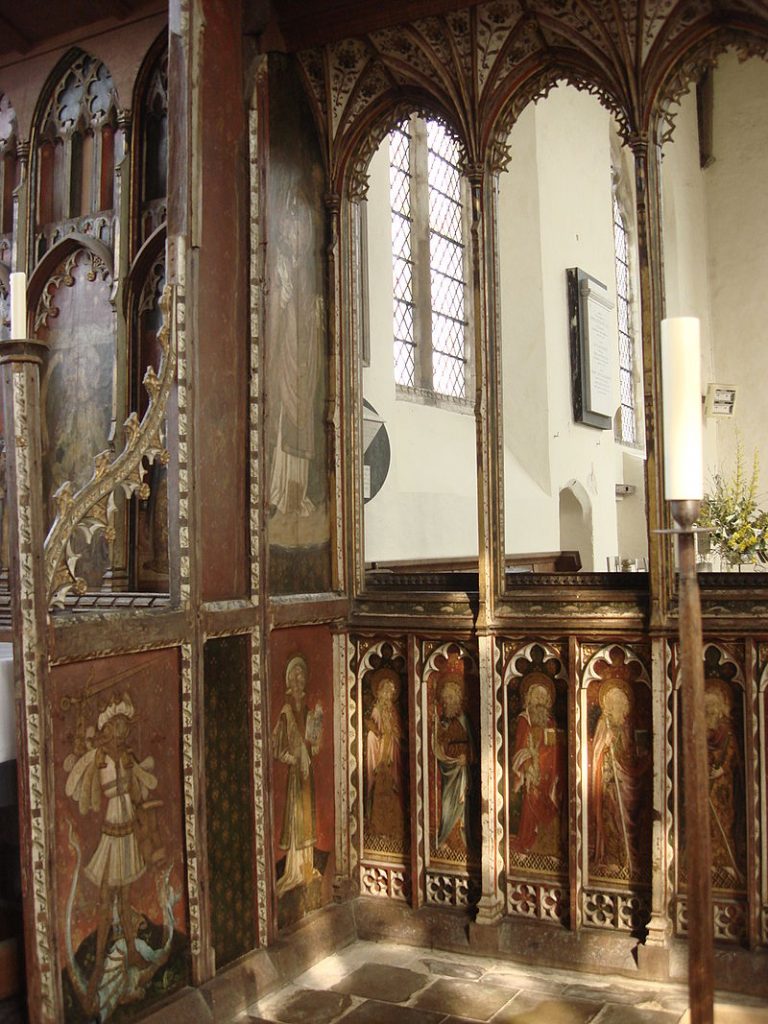
Rood is another word for the Cross. Parish Churches used to have a Rood Screen separating the holy Choir from the more secular Nave. This screen was topped with a statue of the Crucified Jesus nailed to a Rood. Sp Roodmas, is the festival of the Holy Cross.
Roodmas is celebrated on May 3rd and September 14th, although the Church of England aligned has itself with the Catholic Church’s main celebration on September 14th.
Roodmas and the True Cross
The two dates of Roodmas reflects that it commemorates two events:
The first was the discovery of the Holy Cross in Jerusalem in September 14th 326 by Queen Helena. She was the wife of Constantius Chlorus, Augustus and mother of Constantine the Great. In Jerusalem, Queen Helena found the Cross with the nails, and the crown of thorns.
How did she know she had found the true cross? She placed the timber in contact with a deathly sick woman who was revived by it. So, they thought it was the touch of the True Cross. She had most of the Cross sent back to Constantinople in the care of her son, Constantine the Great.
The part of the Holy Cross that was left behind in Jerusalem was taken by the Persians. But it was recovered by the Byzantine Emperor Heraclius in May 3rd 628 in a peace treaty.
See my post on September 14th here.
Shivered into fragments
Over the years, the Cross was shivered into ever smaller pieces. Fragments were sent to Emperors, Kings, Queens, Dukes, Counts, Popes, Bishops, Abbots, and Abbesses. They swapped relics with each other. The fragments were cased in beautiful reliquaries. And were venerated for those of faith and helped those who could be helped by healing by faith.
King Charles III and the True Cross

The Shropshire News reported that two pieces of the True Cross were given to Charles III by the Pope! They have been put into a cross called the Welsh Cross. This was part of the Coronation Procession. The King gave the Cross (I assume with the pieces of the Holy Cross) to the Church in Wales. Let the Shropshire News tell the story:
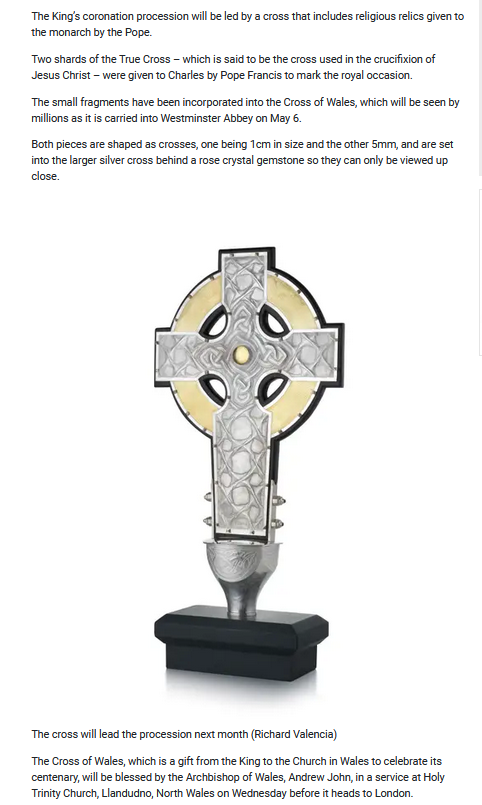
This is quite extraordinarily medieval, and fits in with the news that we were encouraged to take an oath of allegiance to the new King.
I, (Insert full name), do swear that I will be faithful and bear true allegiance to His Majesty King Charles, his heirs and successors, according to law. So help me God.

It is a clear reminder that we are subjects not citizens and news, as a nation, we still set store by superstitions.
The Duke of Buckingham and the True Cross
The Duke of Buckingham had a piece in his collection, which he kept at York House in the early 17th Century. How he got it, I don’t know. But I think he must have acquired it from the aftermath of the destruction of the Reformation. John Tradescant, who looked after the Duke’s collection until Buckingham was murdered, had a piece of the True Cross. Tradecant created Britain’s first Museum, Tradescant’s Ark. Again, I suspect (without any evidence) that he got the fragments from Buckingham. Did he acquire it after the murder? Or shiver off a timber fragment hoping no one would notice?
Guild of the Holy Cross Stratford
The Chapel that Shakespeare’s Father controlled as Bailiff of Stratford on Avon, was dedicated to the Legend of the True Cross, to find out more read my post on September 14th here:
First Written on May 3rd 2023, revised May 3rd 2024, and 2025
The Maypole, This Stinking Idol & the End of May Day May 2nd
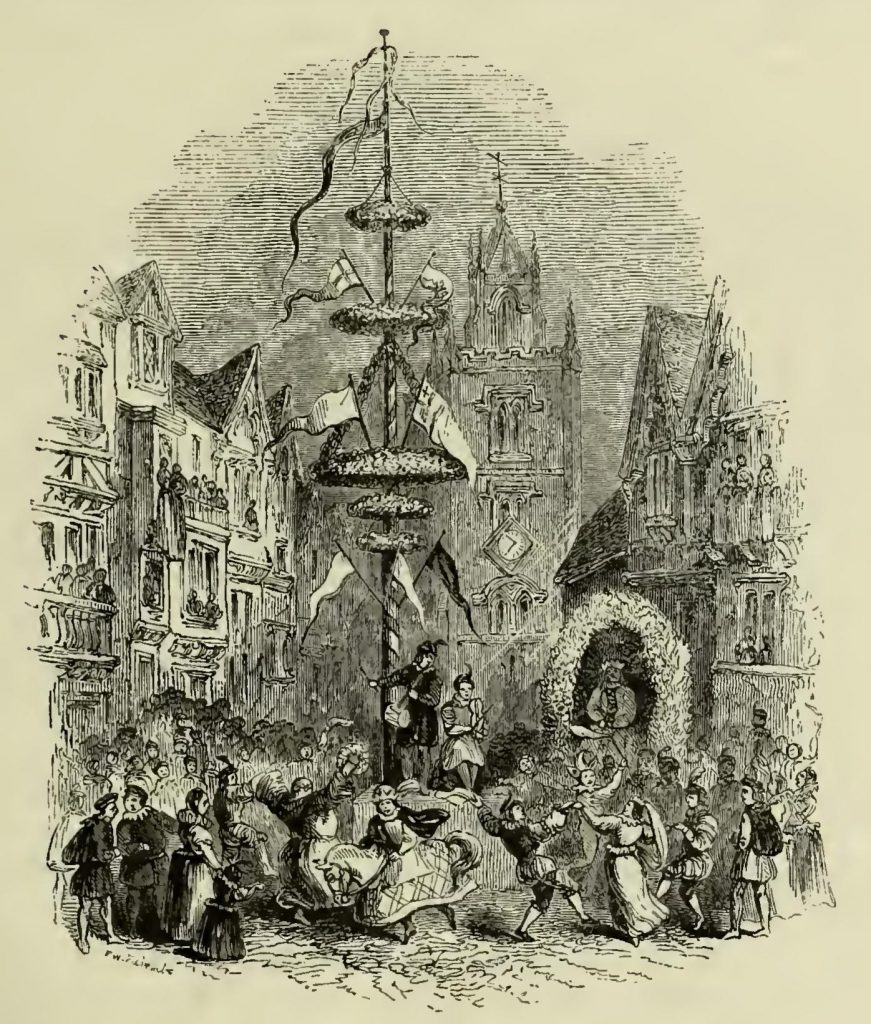
Philip Stubbes, wrote a vitriolic attack on pagan practices in his ‘Anatomy of Abuses in 1583’. He fired a broadside at the tradition of dancing around the Maypole. He said they had: ‘as Superintendent and Lord ouer their pastimes and sportes: namely, Sathan Prince of Hell‘ as they erected ‘this stinking Idoll’. By which he meant the Maypole. Stubbes suggested that of the maids that went out to the woods on May Eve less than one-third returned ‘undefiled‘.
Evil May Day Riots
The Maypole was stored at St Andrew Cornhill, which became known as St Andrew Undershaft. In 1517, it was attacked during the ‘Evil May Day riots’. The main focus of the riot was foreign workers. The Under Sheriff of the time, Thomas More, tried to quell it. But 5,000 troops commanded by the Duke of Northfolk was necessary to regain control of the City. 300 rioters were arrested. One hanged, drawn and quartered, 13 hanged and nearly 300 pardoned after the intercession of Woseley and/or Katherine of Aragon. The shaft was returned to its place under the eves of the houses in Shaft Alley. But apparently banned from being raised again.
1549 May Day Riots
But in 1549, the curate of nearby St Katharine Cree Church made an inflammatory speech. This incited a Puritan mob who cut the shaft into pieces and burnt it. I always imagine the Curate’s sermons to be along the same lines as Phillip Stubbes attack on the Maypole.
Maypole: this Stinking Idol, Rather
Here is a longer description of the May Day Celebrations by Stubbes.
‘But their chiefest iewel they bring from thence is the Maie-poale,
which they bring home with great veneration, as thus: They haue
twentie, or fourtie yoake of Oxen, euery Oxe hauing a sweete
Nosegaie of flowers tyed on the tip of his homes, and these Oxen
drawe home this Maie-poale (this stinking ldoll rather) which is
couered all ouer with Flowers and Hearbes, bound round about
with strings from the top to the bottome, and sometimes painted
with variable collours, with two or three hundred men, women and
children following it, with great deuotion.
And thus being reared vp, with handkerchiefes and flagges streaming
on the top, they strawe the ground round about, bind green boughes about it, set
vp Summer Haules, Bowers, and Arbours hard by it. And then fa!
they to banquet and feast, to leape and daunce about it, as the
a Heathen people did, at the dedication of their ldolles, whereof this
is a perfect patteme, or rather the thing it selfe. I haue heard it
crediblie reported (and that viua voce) by men of great grauity,
credite, and reputation, that of fourtie, threescore, or a hundred Maides,
going to the wood ouemight, there haue scarcely the third part of them returned home againe vndefiled.‘
Phillip Stubbes from ”A Critical Edition Of Philip Stubbes’s Anatomie Of Abuses‘ By Margaret Jane Kidnie.
Restoration Maypole
The unraised pole seems to have survived until the beginning of the Civil War, (1644) when it was destroyed. But at the Restoration of Charles II a new and huge Maypole was ordered. It was joyously erected 134 ft high (41 metres) in the Strand. This one was danced around till 1713 when it was replaced. The original was sold to one Isaac Newton. He used it to support the biggest telescope in Europe which was erected in Wanstead by a friend.
And that, my friends, is how you get from Superstition to Science in one easy story.
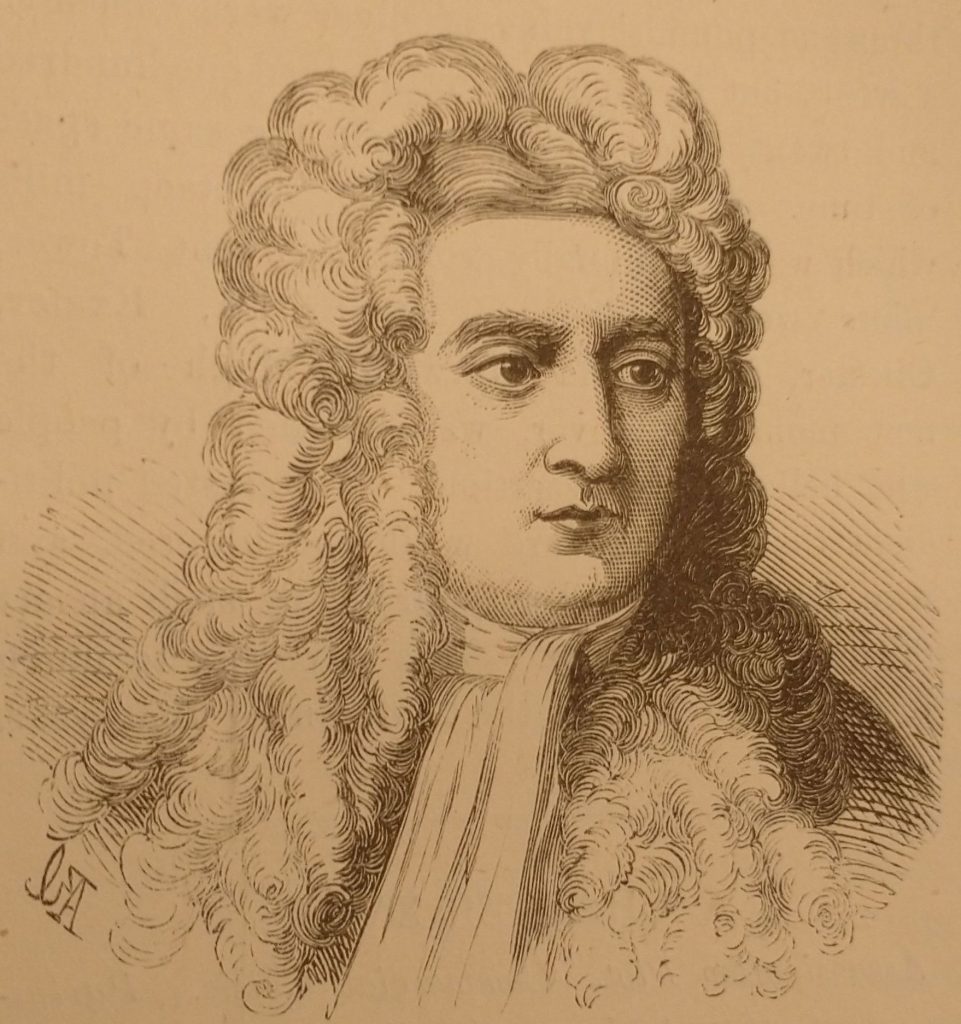
Postscript.
I have always told people that the sermon leading to the destruction of the Shaft in 1549 was made at St Paul. I cannot remember where I read this. The suggestion that the Maypole in Cornhill was not used after 1517 seems strange. Why then would an unused maypole rouse a crowd to riot in 1549? Of the sources I have at hand, the London Encyclopedia mentions the riot of 1517 in its entry on St Andrew Undershaft but doesn’t elaborate more. ‘Layers of London‘ says ‘It was last raised in 1517 when ensuing riots led to the celebration being banned.’ which is definitive sounding. But is it? I wonder if it was banned for a year or two, then allowed again, and finally stopped in 1549?
For more on May Day see yesterday’s post.
On This Day


1995 Allies Statue Statue of Churchill and Roosevelt set up to commemorate 50 years of peace. 30 years later what is the state of the Allies relationship? Topical or what? https://www.iwm.org.uk/memorials/item/memorial/11351
First written in 2023 and revised on May 2nd 2024 and 2025.
May Day May 1st
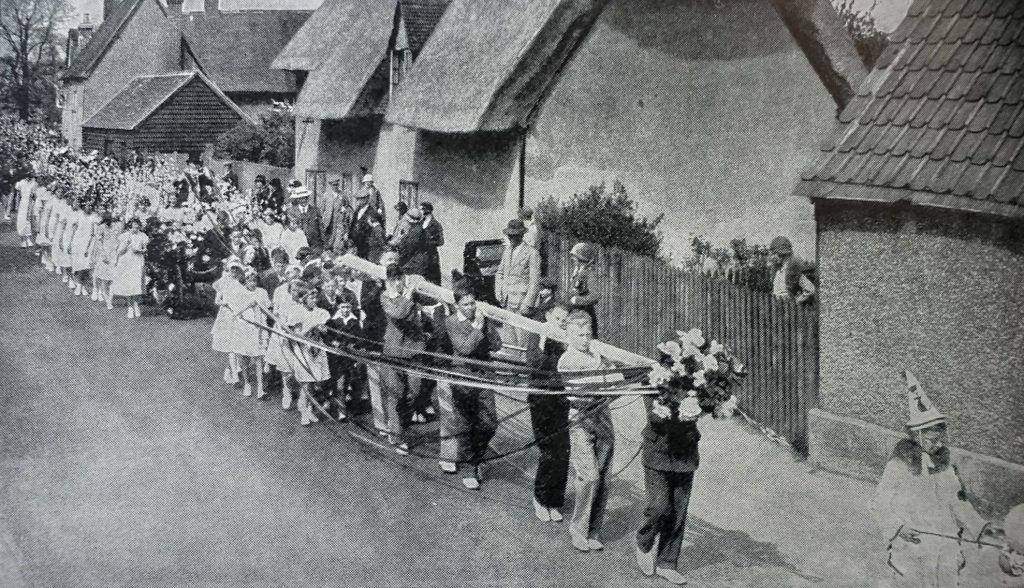
Maypoles were often stored during the year. A few days before May Day they were repainted, and bedecked with May Garlands – mostly made from Hawthorn. The Maypole used in London in 1660 was 134 feet high. Tall straight trees were used, sometimes of Larch, and they might be spliced together to get the requisite height. John Stow says that each parish in London had their own Maypole, or combined with a neighbouring Parish. The main Maypole was on the top of Cornhill, in Leadenhall Street. It was stored under the eves of St Andrew’s Church, which became known as St Andrew’s Undershaft as a result.
Padstow May Day Festival
Padstow holds, perhaps, the most famous May Day festival on May 1st. It feels feels very ‘pagan’ or do I mean it is fuelled by an enormous amount of drink?
Here is a video, watch until you see the ‘obby ‘orse and the teaser dancing.
Why May Eve?
The celebrations begin on May Eve because the Celtic calendar starts the day at Dusk. This seems strange to us who, perversely, ‘start’ our day at Midnight just after everyone has gone to bed! The other choice, and maybe the most logical is Dawn. But Dawn and Dusk are difficult to fix. Midnight was chosen by Julius Caesar when he created the Julian Calendar. Midnight has the virtue of being a fixed metric, being half way between Dawn and Dusk. From the Celtic point of view. The day ends when the Sun goes down over the western horizon. So the end of the old day, is the beginning of the new day. Makes sense?
For Walpurgis Nacht see my post on April 30th here: walpurgis-nacht-april-30th/
Beltane
Celebrations centred around the Bonfire. The day was sacred to the fire God Belenus (Gaulish: Belenos, Belinos, British Belinus, Bel, or Beli), and May Day was called Beltane. Bonfires continued to be a part of the celebration into the 16th Century, and in places until the 20th Century. According to folklore tradition, the bonfire should be made of nine types of wood. They must be collected by nine teams of married men (or first born men). They must not carry any metal with them. The fire has to be lit by rubbing oak sticks together or a wooden awl twisted in a wooden log.
Participants, have to run sunwise around the fire. Oatcakes are distributed, with one being marked with a black spot. The one who collects it has to jump through the fire three times. Bonfires would have been, by choice on the top of hills. But then they were also held in the streets in London.
May celebrations have a similarity to Halloween. This was also a fire festival and both are uncanny times when sprites and spirits abound. Hawthorn was a favoured wood not only because of its beautiful may flower. It was also said to be the wood the crown of thorns was made from. Hawthorn had the power of resisting supernatural forces. Therefore, it was used to protect doors, cribs, cow sheds and other places from witches. Witches, it was said, got their power to fly from potions made from chopped up infants. The best protection was Christening. The custom was that christening took place as early as possible and normally three days after birth. Shakespeare was baptised on 26th April 1564, so we celebrate his birthday on 23rd April. See my post for more on this subject.
Special May Babies
Cribs would be bedecked with Hawthorn and protection might be augmented by a bible, rowan, and garlic. Babies born between May 1 and 8 were thought to be special. They were destined to have power over man and beast. Weddings were frowned upon in Lent and in May, so April became a popular choice for marriage.
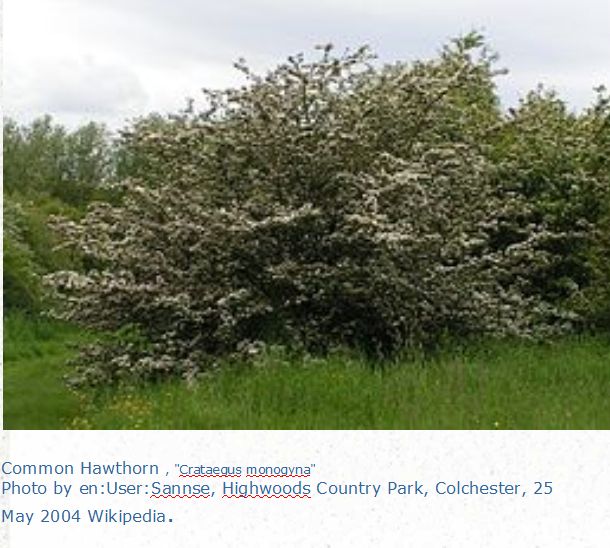
May Dew
After celebrations on May Eve (April 30th), women would go out in the woods to collect May, other flowering plants. They would wash their faces in May Dew preferable from the leaves of Hawthorn. If not from beneath an oak tree, or from a new-made grave. The dew was said to improve their complexion. It was also used for medical conditions such as gout and weak eyes. Thinking of one’s lover on May Day might bring marriage within the year.
May morning would commence with dancing around the Maypole, followed by feasting, and summer games. for more about Maypoles and May Day see my post may-2nd-this-stinking-idol-the-end-of-may-day/

Belenus is a Celtic God of whom very little is clear and unambiguous. He was linked in Gaul with Apollo. The name, some people think, comes from ‘Shining’ but others disagree and think it means ‘Master of Power.’ His association with Irish mythology and the festival of Beltane suggests he was a powerful god in Celtic Europe. Geoffrey of Monmouth has a King called Belinus, and spins a yarn about Belinus and Billingsgate. Linguists prefer the idea that Billingsgate is named after some unknown Saxon called Billings. This may be a little more likely but far less interesting.
See my post on Midsummer for more on Celtic Festivals.
On This Day
1707 The Union of Scotland and England Proclaimed
1945 German Fascist Goebbels kills himself and his entire family
Revised May 1st 2024 and 2025
Walpurgis Nacht & St Erconwald’s Day April 30th

On April 30th, 870AD, St. Walpurga remains were ‘translated’ to Eichstätt. St Willibald had set up the town as the Diocesan centre of this part of Bavaria. So, in Germany today is known as Walpurgis Nacht. I wrote more on my page on St. Walpurga. Walpurga and her two brothers, Willibald and Winibald were Anglo-Saxon Saints who helped convert Germany to Christianity in the 8th Century.
The evening of April 30th is also the beginning of Beltane. Beltane is one of the principal Celtic Festivals, dedicated to the God Belinus. It is a Celtic Fire Ceremony, 6 months before Halloween, and the traditional beginning of Summer. (see my post of Halloween here.) Walpurgis Nacht is also halfway between the Spring equinox and the Summer solstice. So, a very important day in the Celtic Calendar. (see my post on May Day).
The Celtic Day began at Dusk, so May Day begins on 30th April. The Christian Church took over many local traditions and adapted them to the calendar of the Church. So a Saint’s Day, is preceded by an Eve. For example, All Hallows’ Day and Halloween, and May Day and May Eve.
In Sweden it is known as Valborg and as Čarodejnice in the Czech Republic.
A day of Uncanny Weirdness?
As May Day was an uncanny period dedicated to Pagan Deities, Walpurgis Nacht became a time when all the weird things are alive in the world. In response, the Christian Church associated a saint to the day to be a focus for defeating witchcraft. So, it is a popular tradition for this Night to see the burning of an effigy of a witch on a bonfire.
Walpurgis Nacht has really been taken over by Heavy Metal, and I refer you this page to begin your journey down a dark rabbit hole of head-banging rock. https://astromagicklounge.com/2021/04/30/celebrating-walpurgis-night-with-black-sabbath-aleister-crowley/
St Erconwald’s Day

It is also the Feast Day of St Erconwald. He was a Royal Prince who became one of the most famous Bishops of London (675 and 693). He set up Chertsey Abbey and Barking Abbey which his sister, St Ethelburga, became Abbess of. Not only that, but he was known as the light of London and was responsible for rebuilding St Pauls Cathedral. And helping completing the conversion of the Kingdom of Essex.
You might enjoy reading this alliterative poem of the 14th Century about his life. He is one of the patron saints of London, associated with early pilgrimage and many miracles.
First Published in 2024, revised in April 2025
Time to guard children against witches April 29th
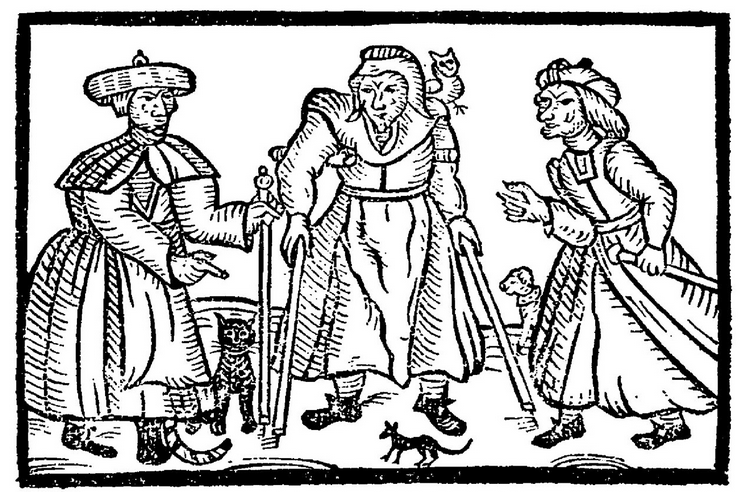
As May Eve approached, which like Halloween, was considered a particularly uncanny time, people were warned to guard against witches stealing their babies:
He (the Devil) teacheth the witches to make ointments of the bowels and members of children, whereby they ride in the air and accomplish all their desires. So as, if they be any children unbaptized, or not guarded with the sign of the cross or orisons: then the witches may and do catch them from their mother’s side at night, or out of their cradles. …. and after burial steal them out of the graves, then seethe them in a cauldron until their flesh been made possible.
Reginald Scott ‘The Discovery of Witchcraft’ 1594 (from ‘The perpetual Almanack of Folklore’ by Charles Kightley). Please note that Reginald Scott’s book was actually against the idea of witchcraft, i.e. he was debunking it. (for more on Reginald Scott read my post here)
Keeping Witches away
Ways to keep witches away were various, but baptising your children early was the best method. As you will have seen in previous posts, children were normally baptised as soon as possible. Normally, three days after birth in the early modern period.) There were various ways of protecting against witches including saying prayers (orisons), hanging garlic, bread, rowan-leaves, around the cradle.
Witch marks
In archaeological surveys of timber framed buildings increasing numbers of reports of ‘witches’ marks have been discovered. They are now so ubiquitous that it seems most people felt the need to deploy them to secure their houses. Or was it the Carpenters and Builders who felt the need to protect their work? It was believed that witches gained entry where there was an inlet of wind. So doors, windows, chimneys, and anywhere there was a draft. These would be marked by pentagons, which represent the five wounds of Christ. Also used were a variety of other marks ‘chequerboards, mesh patterns, peltas (a type of knot work design) and circle’. https://theartssociety.org/arts-news-features/ancient-symbols-once-used-ward-away-witches is an excellent read and gives more detail.
Also this article makes the case that they are not specifically anti-witch marks, but general marks to ward off evil. This is worth reading. The illustration below comes from the article.

Tam O’Shanter
Robert Burns poem ‘Tam O’Shanter’ gives a graphic, fictional, account of a witches’ coven presided over by the Devil (auld Nick) himself which features ‘wee, unchristen’d bairns‘. Tam, drunk, has come upon a witches coven, presided over by the devil himself.
And, vow! Tam saw an unco sight!
Warlocks and witches in a dance;
Nae cotillion brent new frae France,
But hornpipes, jigs, strathspeys, and reels,
Put life and mettle in their heels.
A winnock-bunker in the east,
There sat auld Nick, in shape o’ beast;
A towzie tyke, black, grim, and large,
To gie them music was his charge:
He screw’d the pipes and gart them skirl,
Till roof and rafters a’ did dirl.—
Coffins stood round, like open presses,
That shaw’d the dead in their last dresses;
And by some devilish cantraip slight
Each in its cauld hand held a light.—
By which heroic Tam was able
To note upon the haly table,
A murderer’s banes in gibbet airns;
Twa span-lang, wee, unchristen’d bairns;
A thief, new-cutted frae a rape,
Wi’ his last gasp his gab did gape;
Five tomahawks, wi’ blude red-rusted;
Five scymitars, wi’ murder crusted;
A garter, which a babe had strangled;
A knife, a father’s throat had mangled,
Whom his ain son o’ life bereft,
The grey hairs yet stack to the heft;
Wi’ mair o’ horrible and awefu’,
Which even to name wad be unlawfu’.
I talked more about Tam O’Shanter and the Cutty Sark here and to read the whole poem see below. Please do have a look and when you read it read it quick. Loud and don’t worry about how to pronounce it or understand it, just enjoy the ride!
Have a look at my post on the Cutty Sark for more of Tam O’Shanter.
Written in 2023 revised April 2024, 2025
St George’s Day Again? April 28th

By Rufus46 – Own work, CC BY-SA 3.0,
https://commons.wikimedia.org/w/index.php?curid=35346561
St George’s Day is normally on 23rd April but not this year!
When St George’s Day falls between Palm Sunday and the Second Sunday after Easter it is transferred to the Monday after the Second Sunday of Easter.
Got that? No, nor did I. Not many people know that. it seems. Last time it happened, Keir Starmer, Theresa May, and London Mayor Sadiq Khan all got it wrong in 2019. The first time I heard about this was 2025, when Keir Starmer appeared to have got it wrong again. A cleric fulminated about illiterate people who get it wrong!
But I think the Church should stop such silly practices. Either it is or it isn’t.
To see my post on St George’s Day please follow this link.
On this Day
1789 Fletcher Christian led the Mutiny on the Bounty. Captain Bligh is buried
1945 Populist, Fascist, Dictator Benito Mussolini captured by partisans and killed.
First Published on 2025 April 28th
Guernica & War from the Air April 26th 1937

Franco ordered the bombing as part of his campaign to overthrow the Basque Government. The Town was badly damaged and 1,654 civilians were killed. It was undertaken by ‘the Condor Legion of Nazi Germany‘s Luftwaffe and the Italian Aviazione Legionaria‘ (Wikipedia). Picasso began his famous painting almost immediately after he heard an eyewitness account of the attack. The iconic painting was finished by 4 June 1937. The bombing showed the potential damage war from the air could do to crowded Cities. The painting became one of the most famous campaigning works of art.
The War from the Air

Illustration by A. C. Michael of Pall Mall Magazine –
Aerial warfare became a reality as soon as the Montgolfier Brothers flew the first Hot Air Balloon. In the Revolutionary Wars, the French used them for reconnaissance. Napoleon considered transporting troops by balloon in an invasion of Britain. With the arrival of planes and the development of the Zeppelin. Air warfare became a feature of speculative fiction, and began to absorb the planners.
H G Wells book, illustrated above, featured a war between Germany and the United Statesin which New York is obliterated by Aerial Bombing. This was written in 1908
In World War 1 London was the focus of a series of Zeppelin and Aeroplane raids. These killed over 500 people. (see my post on the London Zeppelin raid of Sept 8th 1916). As planes developed in capacity, war departments created plans that seem now to have been exaggerated. It is thought that Appeasement was partly a response to the feared casualties from war in the air. Before the Blitz, the authorities were planning for 1 million killed in London and double that number of people deranged by fear. In the event, casualties were far less, some 43,000 killed. However, 2 million houses were destroyed. The scale of destruction was fairly accurately predicted but the casualties exaggerated.
(see my post on the-ultimate-raf-london-blitz-story)
On this Day
2025 The Tweed Run is a mass cycle ride around London with everyone dressed in Tweeds. See here for some photos of last year’s run. https://www.tweedrun.com
1994 The new South African constitution came into force and democratic elections were held.
First Published on April 26th 2025
